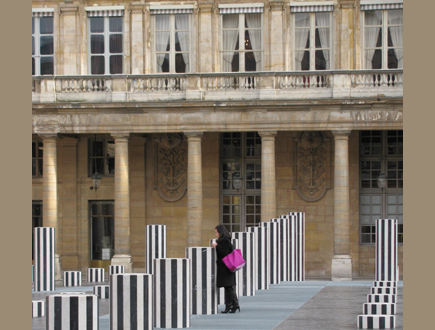
The court of honor behind the Palais Royal is surrounded by the graceful 17th- and 18th-century French Classicism that is at the heart of the beauty of Paris. It’s fitting, then, that the city’s cultural microcosm should be found here.
On the court of honor’s west side stands the Comédie Française, the national headquarters of classic theater and fine diction. On its east side sits the theater’s patron, the Ministry of Culture. On the south side is the royal palace itself, Cardinal Richelieu’s palace that became royal when, as a child king, Louis XIV and his mother lived here so as to avoid the crushing, plotting crowds in the Louvre. The palace is now home to the Conseil d’Etat, France’s highest administrative jurisdiction and advisor to the government on the legality of draft laws and decrees.

To the south side extends the garden. It’s open to passage yet intimate enough to feel confidential, as though everyone but you has gone off to church, to work, to school, or more likely to the Louvre.
But I’ve come here today not to luxuriate in French Classicism but rather to visit that other element that makes the court of honor a microcosm of culture in Paris: the newly restored work by artist Daniel Buren, Les Deux Plateaux (1986).
The Two Plateaus, generally referred to as Buren’s Columns, are a series of black and white columns of different heights that, in the mid-1980s, served as a side dish in an ongoing debate about the role that modernism plays in the city . But urban planners, royalist presidents, culture mavens, and critics of every stripe had and have bigger fish to fry: the Montparnasse Tower, the Pompidou Center, the Pyramid of the Louvre, the Mitterand National Library, the Branly Museum, and the Beaugrenelle Quarter, to mention the most hotly debated urban projects of the past 40 years.
Due to the important role that the French state plays in developments in Paris, the national passion for abstract cultural debates, and the Parisian tendency to cultural possessiveness, no unveiling is complete in Paris until every one of its residents—and a good many of its visitors—has provided an opinion.
The debate over Buren’s Columns already seemed quaint by the time the Pyramid of the Louvre was underway a few years later. I’ve walked by the columns numerous times with visitors, and invariably those visitors make the same comment “What’s this?”
My own “What’s this?” moment came over 20 years ago. It took a few years after that, but Buren’s Columns have grown on me in a way that Pei’s Pyramid, which leaves me indifferent, has not. I see the Columns as an amiable yet off-beat guest at a formal party and the Pyramid as a highly polished guest who’s forever trying to both fit it and stand out.
So what is this?
Prior to Buren’s Columns the Palais Royal’s court of honor was essentially lost space. The intent of offering the space to art (perhaps this is better called archisculpture), was to make the space inviting yet not too comfortable so that it would remain a place of passage, an integrated and inquisitive place of passage.
Buren’s work nonchalantly takes up the stripes of the window awnings and the columns of the court of honor and then goes about filling and ordering its own space. The surrounding buildings, having been acknowledged and questioned, are left to fend for themselves.
Habitual passers-through never fail to slow down and take notice as they pass, as though glimpsing a forgotten game of chess to see if any of the pieces have been moved. Meanwhile, for visitors, Buren’s work gives rise to excitable and restless communication as they shout to or photograph each other from the columns or walk about them as though trying to fathom who put them here.
A metal grid reveals the passage of a stream beneath the plateaus. There are visitors who try to throw coins onto a column that stands in the middle of a streamonly to have their dreams fished out by children with string and magnet.
The restoration work was mainly necessary so as to stabilize the plateaus, so other than being cleaner and shinier now the appearance is much the same as before. If you’ve never been to Paris, by all means come by to take part in the conversation. If you have been here before, come again to see if your opinion has changed. And if you live in Paris, stop by whenever you need a reminder of why you do.
© 2010, Gary Lee Kraut

